Shijie Chen
The R2D2 Deep Neural Network Series for Scalable Non-Cartesian Magnetic Resonance Imaging
Mar 13, 2025Abstract:We introduce the R2D2 Deep Neural Network (DNN) series paradigm for fast and scalable image reconstruction from highly-accelerated non-Cartesian k-space acquisitions in Magnetic Resonance Imaging (MRI). While unrolled DNN architectures provide a robust image formation approach via data-consistency layers, embedding non-uniform fast Fourier transform operators in a DNN can become impractical to train at large scale, e.g in 2D MRI with a large number of coils, or for higher-dimensional imaging. Plug-and-play approaches that alternate a learned denoiser blind to the measurement setting with a data-consistency step are not affected by this limitation but their highly iterative nature implies slow reconstruction. To address this scalability challenge, we leverage the R2D2 paradigm that was recently introduced to enable ultra-fast reconstruction for large-scale Fourier imaging in radio astronomy. R2D2's reconstruction is formed as a series of residual images iteratively estimated as outputs of DNN modules taking the previous iteration's data residual as input. The method can be interpreted as a learned version of the Matching Pursuit algorithm. A series of R2D2 DNN modules were sequentially trained in a supervised manner on the fastMRI dataset and validated for 2D multi-coil MRI in simulation and on real data, targeting highly under-sampled radial k-space sampling. Results suggest that a series with only few DNNs achieves superior reconstruction quality over its unrolled incarnation R2D2-Net (whose training is also much less scalable), and over the state-of-the-art diffusion-based "Decomposed Diffusion Sampler" approach (also characterised by a slower reconstruction process).
ScienceAgentBench: Toward Rigorous Assessment of Language Agents for Data-Driven Scientific Discovery
Oct 07, 2024



Abstract:The advancements of language language models (LLMs) have piqued growing interest in developing LLM-based language agents to automate scientific discovery end-to-end, which has sparked both excitement and skepticism about the true capabilities of such agents. In this work, we argue that for an agent to fully automate scientific discovery, it must be able to complete all essential tasks in the workflow. Thus, we call for rigorous assessment of agents on individual tasks in a scientific workflow before making bold claims on end-to-end automation. To this end, we present ScienceAgentBench, a new benchmark for evaluating language agents for data-driven scientific discovery. To ensure the scientific authenticity and real-world relevance of our benchmark, we extract 102 tasks from 44 peer-reviewed publications in four disciplines and engage nine subject matter experts to validate them. We unify the target output for every task to a self-contained Python program file and employ an array of evaluation metrics to examine the generated programs, execution results, and costs. Each task goes through multiple rounds of manual validation by annotators and subject matter experts to ensure its annotation quality and scientific plausibility. We also propose two effective strategies to mitigate data contamination concerns. Using our benchmark, we evaluate five open-weight and proprietary LLMs, each with three frameworks: direct prompting, OpenHands, and self-debug. Given three attempts for each task, the best-performing agent can only solve 32.4% of the tasks independently and 34.3% with expert-provided knowledge. These results underscore the limited capacities of current language agents in generating code for data-driven discovery, let alone end-to-end automation for scientific research.
Attention in Large Language Models Yields Efficient Zero-Shot Re-Rankers
Oct 03, 2024Abstract:Information retrieval (IR) systems have played a vital role in modern digital life and have cemented their continued usefulness in this new era of generative AI via retrieval-augmented generation. With strong language processing capabilities and remarkable versatility, large language models (LLMs) have become popular choices for zero-shot re-ranking in IR systems. So far, LLM-based re-ranking methods rely on strong generative capabilities, which restricts their use to either specialized or powerful proprietary models. Given these restrictions, we ask: is autoregressive generation necessary and optimal for LLMs to perform re-ranking? We hypothesize that there are abundant signals relevant to re-ranking within LLMs that might not be used to their full potential via generation. To more directly leverage such signals, we propose in-context re-ranking (ICR), a novel method that leverages the change in attention pattern caused by the search query for accurate and efficient re-ranking. To mitigate the intrinsic biases in LLMs, we propose a calibration method using a content-free query. Due to the absence of generation, ICR only requires two ($O(1)$) forward passes to re-rank $N$ documents, making it substantially more efficient than generative re-ranking methods that require at least $O(N)$ forward passes. Our novel design also enables ICR to be applied to any LLM without specialized training while guaranteeing a well-formed ranking. Extensive experiments with two popular open-weight LLMs on standard single-hop and multi-hop information retrieval benchmarks show that ICR outperforms RankGPT while cutting the latency by more than 60% in practice. Through detailed analyses, we show that ICR's performance is specially strong on tasks that require more complex re-ranking signals. Our findings call for further exploration on novel ways of utilizing open-weight LLMs beyond text generation.
Roll Up Your Sleeves: Working with a Collaborative and Engaging Task-Oriented Dialogue System
Jul 29, 2023Abstract:We introduce TacoBot, a user-centered task-oriented digital assistant designed to guide users through complex real-world tasks with multiple steps. Covering a wide range of cooking and how-to tasks, we aim to deliver a collaborative and engaging dialogue experience. Equipped with language understanding, dialogue management, and response generation components supported by a robust search engine, TacoBot ensures efficient task assistance. To enhance the dialogue experience, we explore a series of data augmentation strategies using LLMs to train advanced neural models continuously. TacoBot builds upon our successful participation in the inaugural Alexa Prize TaskBot Challenge, where our team secured third place among ten competing teams. We offer TacoBot as an open-source framework that serves as a practical example for deploying task-oriented dialogue systems.
Mind2Web: Towards a Generalist Agent for the Web
Jun 15, 2023



Abstract:We introduce Mind2Web, the first dataset for developing and evaluating generalist agents for the web that can follow language instructions to complete complex tasks on any website. Existing datasets for web agents either use simulated websites or only cover a limited set of websites and tasks, thus not suitable for generalist web agents. With over 2,000 open-ended tasks collected from 137 websites spanning 31 domains and crowdsourced action sequences for the tasks, Mind2Web provides three necessary ingredients for building generalist web agents: 1) diverse domains, websites, and tasks, 2) use of real-world websites instead of simulated and simplified ones, and 3) a broad spectrum of user interaction patterns. Based on Mind2Web, we conduct an initial exploration of using large language models (LLMs) for building generalist web agents. While the raw HTML of real-world websites are often too large to be fed to LLMs, we show that first filtering it with a small LM significantly improves the effectiveness and efficiency of LLMs. Our solution demonstrates a decent level of performance, even on websites or entire domains the model has never seen before, but there is still a substantial room to improve towards truly generalizable agents. We open-source our dataset, model implementation, and trained models (https://osu-nlp-group.github.io/Mind2Web) to facilitate further research on building a generalist agent for the web.
Error Detection for Text-to-SQL Semantic Parsing
May 23, 2023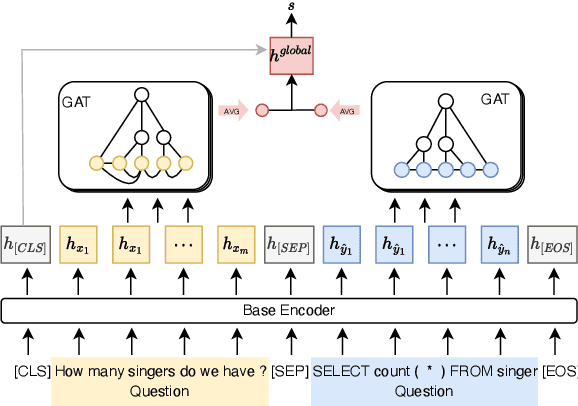

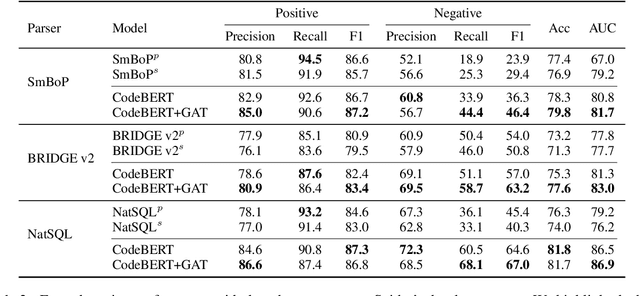
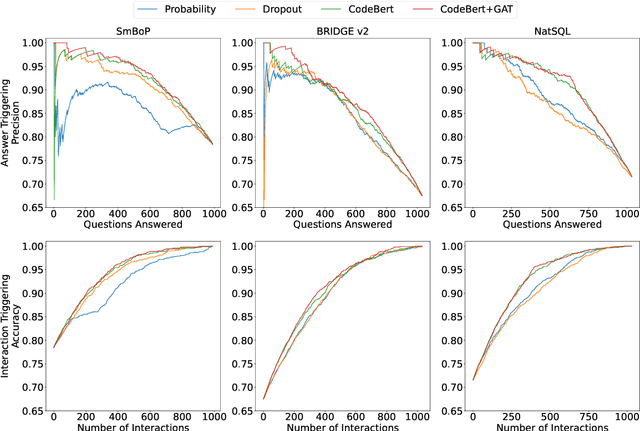
Abstract:Despite remarkable progress in text-to-SQL semantic parsing in recent years, the performance of existing parsers is still far from perfect. At the same time, modern deep learning based text-to-SQL parsers are often over-confident and thus casting doubt on their trustworthiness when deployed for real use. To that end, we propose to build a parser-independent error detection model for text-to-SQL semantic parsing. The proposed model is based on pre-trained language model of code and is enhanced with structural features learned by graph neural networks. We train our model on realistic parsing errors collected from a cross-domain setting. Experiments with three strong text-to-SQL parsers featuring different decoding mechanisms show that our approach outperforms parser-dependent uncertainty metrics and could effectively improve the performance and usability of text-to-SQL semantic parsers regardless of their architectures.
Text-to-SQL Error Correction with Language Models of Code
May 22, 2023Abstract:Despite recent progress in text-to-SQL parsing, current semantic parsers are still not accurate enough for practical use. In this paper, we investigate how to build automatic text-to-SQL error correction models. Noticing that token-level edits are out of context and sometimes ambiguous, we propose building clause-level edit models instead. Besides, while most language models of code are not specifically pre-trained for SQL, they know common data structures and their operations in programming languages such as Python. Thus, we propose a novel representation for SQL queries and their edits that adheres more closely to the pre-training corpora of language models of code. Our error correction model improves the exact set match accuracy of different parsers by 2.4-6.5 and obtains up to 4.3 point absolute improvement over two strong baselines. Our code and data are available at https://github.com/OSU-NLP-Group/Auto-SQL-Correction.
Bootstrapping a User-Centered Task-Oriented Dialogue System
Jul 11, 2022



Abstract:We present TacoBot, a task-oriented dialogue system built for the inaugural Alexa Prize TaskBot Challenge, which assists users in completing multi-step cooking and home improvement tasks. TacoBot is designed with a user-centered principle and aspires to deliver a collaborative and accessible dialogue experience. Towards that end, it is equipped with accurate language understanding, flexible dialogue management, and engaging response generation. Furthermore, TacoBot is backed by a strong search engine and an automated end-to-end test suite. In bootstrapping the development of TacoBot, we explore a series of data augmentation strategies to train advanced neural language processing models and continuously improve the dialogue experience with collected real conversations. At the end of the semifinals, TacoBot achieved an average rating of 3.55/5.0.
Multi-Task Learning in Natural Language Processing: An Overview
Sep 19, 2021



Abstract:Deep learning approaches have achieved great success in the field of Natural Language Processing (NLP). However, deep neural models often suffer from overfitting and data scarcity problems that are pervasive in NLP tasks. In recent years, Multi-Task Learning (MTL), which can leverage useful information of related tasks to achieve simultaneous performance improvement on multiple related tasks, has been used to handle these problems. In this paper, we give an overview of the use of MTL in NLP tasks. We first review MTL architectures used in NLP tasks and categorize them into four classes, including the parallel architecture, hierarchical architecture, modular architecture, and generative adversarial architecture. Then we present optimization techniques on loss construction, data sampling, and task scheduling to properly train a multi-task model. After presenting applications of MTL in a variety of NLP tasks, we introduce some benchmark datasets. Finally, we make a conclusion and discuss several possible research directions in this field.
Technical report on Conversational Question Answering
Sep 24, 2019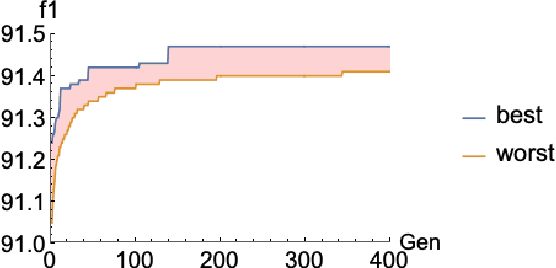
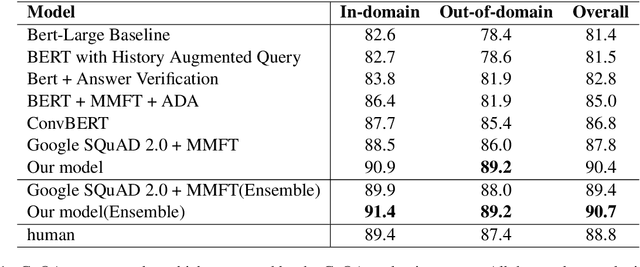
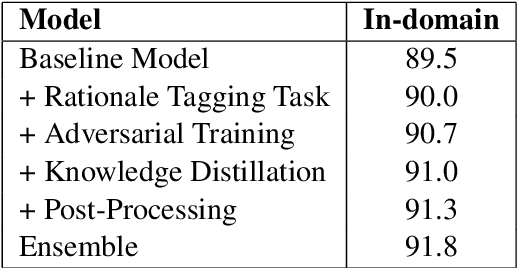
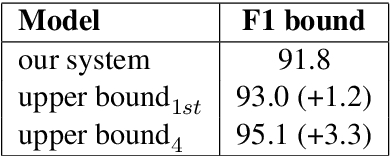
Abstract:Conversational Question Answering is a challenging task since it requires understanding of conversational history. In this project, we propose a new system RoBERTa + AT +KD, which involves rationale tagging multi-task, adversarial training, knowledge distillation and a linguistic post-process strategy. Our single model achieves 90.4(F1) on the CoQA test set without data augmentation, outperforming the current state-of-the-art single model by 2.6% F1.
 Add to Chrome
Add to Chrome Add to Firefox
Add to Firefox Add to Edge
Add to Edge